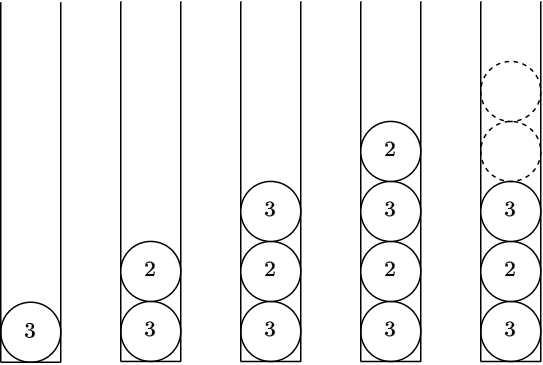9556: ABC240 —— D - Strange Balls
[Creator : ]
Description
Takahashi has $N$ balls. Each ball has an integer not less than $2$ written on it. He will insert them in a cylinder one by one. The integer written on the $i$-th ball is $a_i$.
The balls are made of special material. When $k$ balls with $k$ $(k \geq 2)$ written on them line up in a row, all these $k$ balls will disappear.
For each $i$ $(1 \leq i \leq N)$, find the number of balls after inserting the $i$-th ball.
The balls are made of special material. When $k$ balls with $k$ $(k \geq 2)$ written on them line up in a row, all these $k$ balls will disappear.
For each $i$ $(1 \leq i \leq N)$, find the number of balls after inserting the $i$-th ball.
Input
Input is given from Standard Input in the following format:
```
$N$
$a_1$ $\ldots$ $a_N$
```
```
$N$
$a_1$ $\ldots$ $a_N$
```
Output
Print $N$ lines. The $i$-th line $(1 \leq i \leq N)$ should contain the number of balls after inserting the $i$-th ball.
Constraints
- $1 \leq N \leq 2 \times 10^5$
- $2 \leq a_i \leq 2 \times 10^5 \, (1 \leq i \leq N)$
- All values in input are integers.
- $2 \leq a_i \leq 2 \times 10^5 \, (1 \leq i \leq N)$
- All values in input are integers.
Sample 1 Input
5
3 2 3 2 2
Sample 1 Output
1
2
3
4
3
The content of the cylinder changes as follows.
- After inserting the 1-st ball, the cylinder contains the ball with 3.
- After inserting the 2-nd ball, the cylinder contains 3,2 from bottom to top.
- After inserting the 3-rd ball, the cylinder contains 3,2,3 from bottom to top.
- After inserting the 4-th ball, the cylinder contains 3,2,3,2 from bottom to top.
- After inserting the 5-th ball, the cylinder momentarily has 3,2,3,2,2 from bottom to top. The two consecutive balls with 22 disappear, and the cylinder eventually contains 3,2,3 from bottom to top.

Sample 2 Input
10
2 3 2 3 3 3 2 3 3 2
Sample 2 Output
1
2
3
4
5
3
2
3
1
0